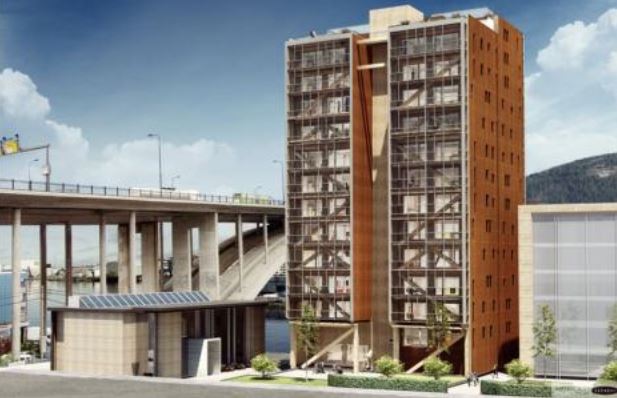A timber skyscraper 80 floors high – called The Toothpick – has been proposed for London. The 300-metre tall building would be integrated within the Barbican, Europe’s largest multi-arts and conference centre in the City of London.
The first concern for most lay people when hearing about a proposal to make an ultra-tall building mainly out of wood is the fire risk. The researchers say their timber skyscraper would be as safe as one built using steel and concrete.
The project moves one step closer to reality this week after researchers presented Boris Johnson, the Mayor of London, with conceptual plans for London’s first skyscraper made of wood.
 The Toothpick, if approved and built, would be London’s second-tallest building. (Image: cam.ac.uk)
The Toothpick, if approved and built, would be London’s second-tallest building. (Image: cam.ac.uk)
Researchers from the Department of Architecture at the University of Cambridge, together with PLP Architecture and engineers Smith & Wallwork, are working together on the future development of tall timber buildings in the centre of London.
Interest for timber in skyscraper construction growing
Using timber as a structural material in skyscrapers is an area of growing interest because of its several potential benefits; the most obvious being that wood is a renewable resource, unlike current construction methods which use steel and concrete.
The research team is also looking into other potential benefits of using timber, including the considerable reduction in the overall weight of buildings, increased fire resistance, and better construction timescales.
The current proposals being developed would create more than 1,000 new residential units in a mixed-use tower comprising one million square feet (92,900 square metres), integrated within the Barbican.
 Just because it is made of wood, in no way means that it would be a greater fire risk, say the researchers. In fact, the finished building would likely be safer than most steel and concrete constructions. (Image: cam.ac.uk)
Just because it is made of wood, in no way means that it would be a greater fire risk, say the researchers. In fact, the finished building would likely be safer than most steel and concrete constructions. (Image: cam.ac.uk)
Regarding the builders’ aims when the Barbican was first built, Director of Cambridge’s Centre for Natural Material Innovation, Dr. Michael Ramage said:
“The Barbican was designed in the middle of the last century to bring residential living into the city of London – and it was successful. We’ve put our proposals on the Barbican as a way to imagine what the future of construction could look like in the 21st century.”
“If London is going to survive it needs to increasingly densify. One way is taller buildings. We believe people have a greater affinity for taller buildings in natural materials rather than steel and concrete towers.”
“The fundamental premise is that timber and other natural materials are vastly underused and we don’t give them nearly enough credit. Nearly every historic building, from King’s College Chapel to Westminster Hall, has made extensive use of timber.”
 The current tallest timber building is a 14-storey luxury apartment block in central Bergen Norway. It is 49 metres tall. Compared to the nearly 300 metres planned for The Toothpick in London, it is very small. (Image: bdcnetwork.com)
The current tallest timber building is a 14-storey luxury apartment block in central Bergen Norway. It is 49 metres tall. Compared to the nearly 300 metres planned for The Toothpick in London, it is very small. (Image: bdcnetwork.com)
Timber could improve urban quality of life
Kevin Flanagan, a Partner at PLP Architecture said:
“We now live predominantly in cities and so the proposals have been designed to improve our well-being in an urban context. Timber buildings have the potential architecturally to create a more pleasing, relaxed, sociable and creative urban experience.”
“Our firm is currently designing many of London’s tall buildings, and the use of timber could transform the way we build in this city. We are excited to be working with the University and with Smith and Wallwork on this ground breaking design- and engineering-based research.”
The researchers say they aim to make timber buildings with unique designs, rather than simply copying existing concrete and steel constructions and replacing materials with wood.
The transition from concrete & steel to timber construction may have a broader impact on urban environments and built form, and offers architects, engineers and planners not only to rethink the aesthetics of skyscrapers, but also the structural methodologies informing their design.
Just as major innovations in glass, concrete and steel revolutionised buildings in the nineteenth and twentieth centuries, creating the Parisian arcades described by Walter Benjamin (1892-1940) and Joseph Paxton’s Crystal Palace, innovations in timber could lead to completely new experiences of the city in the 21st century. The kind of timber these new buildings would use is regarded as a ‘crop’.
The amount of crop forest there is globally is currently expanding. Just Canada could produce over 15 billion m3 of crop forest in the next seven decades, enough to house approximately one billion people.
Would be London’s 2nd-tallest building
Currently, the tallest timber building in the world is in Bergen, Norway – a 14-storey apartment block. The proposals the Mayor of London received included concepts for a timber tower almost 300 metres (984 feet) height.
If all goes according to plan and the building is completed, it would be the second tallest building in Britain’s capital, after The Strand, which is 309.67 metres (1,016 ft) tall.
Regarding the proposal, Dr Ramage added:
“We’ve designed the architecture and engineering and demonstrated it will stand, but this is at a scale no one has attempted to build before. We are developing a new understanding of primary challenges in structure and construction.”
“There is a lot of work ahead, but we are confident of meeting all the challenges before us.”
Isn’t wood a fire risk?
The most obvious concern for potential dwellers of homes built mainly of wood is fire risk.
However, the researchers involved in this project said their proposed building would at least meet – and maybe even exceed – every single existing fire regulation currently in place for concrete and steel buildings.
Recent studies have also demonstrated that timber buildings can have a positive effect on the health of their occupants and users.
Other studies, also carried out recently, have also shown that pupils taught in schools with timber structure may achieve better academic results compared to their counterparts in schools made of concrete.
The designs planned for the Barbican are the first in a series of timber skyscrapers developed by Cambridge University researchers in association with world-famous architects and structural engineers.
The research has been funded by the Engineering and Physical Sciences Research Council, the United Kingdom’s main agency for funding research in engineering and the physical sciences.
Engineering company Smith and Wallwork carried out structural engineering analysis of several different frame concepts using massive timber elements that would see about 65,000m3 of engineered timber support London’s first timber skyscraper.
Smith and Wallwork wrote on its website:
“The final design utilised a buttressed mega-truss solution with 2.5m x 2.5m timber columns and 1.75m thick timber walls. Despite using significant volumes of timber the structure would be 4x lighter than an equivalent concrete frame tower.”
